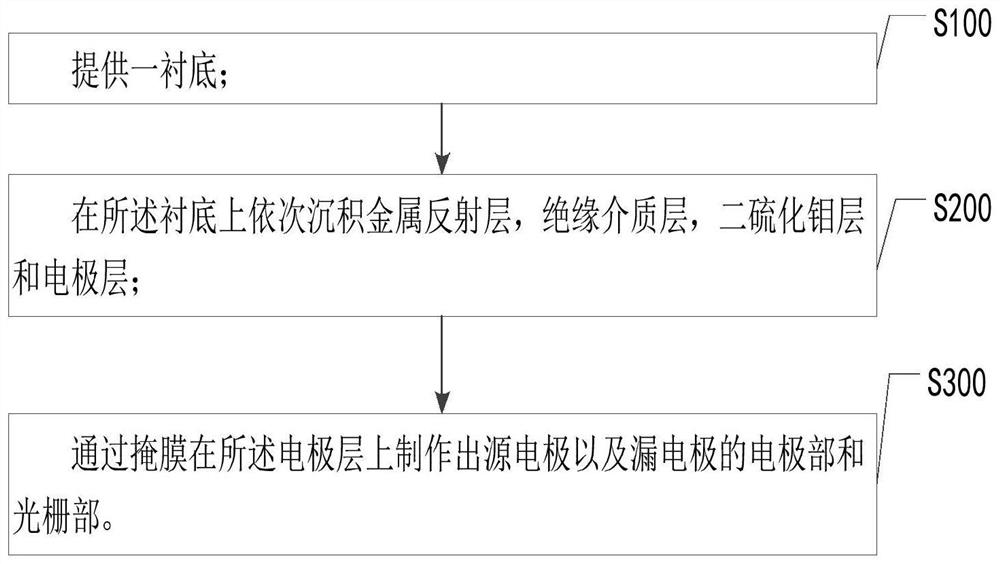Molybdenum disulfide photoelectric detector and preparation method thereof
A technology of photodetectors and molybdenum disulfide, applied in circuits, electrical components, semiconductor devices, etc., can solve the problems of low photoresponse efficiency and achieve the effect of enhancing photoresponse and breaking symmetry
- Summary
- Abstract
- Description
- Claims
- Application Information
AI Technical Summary
Problems solved by technology
Method used
Image
Examples
preparation example Construction
[0037] see figure 2 , the second aspect of the present invention provides a method for preparing a molybdenum disulfide photodetector, comprising:
[0038] S100, providing a substrate;
[0039]S200, sequentially depositing a metal reflective layer, an insulating dielectric layer, a molybdenum disulfide layer and an electrode layer on the substrate;
[0040] S300, fabricating the electrode part and the grating part of the source electrode and the drain electrode on the electrode layer through a mask.
[0041] The molybdenum disulfide photodetector of the present invention is integrated with molybdenum disulfide through a metamaterial optical antenna, and utilizes plasmon resonance to realize the field of the local tangential photon mode (the electric field is mainly parallel to the two-dimensional plane of molybdenum disulfide) enhanced. Based on the matching of the tangential photon mode and the light absorption direction of molybdenum disulfide, the equivalent absorption ...
Embodiment 1
[0043] The concrete structure of a kind of molybdenum disulfide photodetector of the present invention is as follows:
[0044] The structure of the molybdenum disulfide photodetector includes: a source electrode, a drain electrode integrated with a grating, a single molybdenum disulfide layer, an insulating medium layer, and a metal reflection layer. see figure 1 , the source electrode and the drain electrode integrated with the grating are a layer of thickness h 3 A highly conductive metal whose thickness h 3 Not less than twice the skin depth of the electromagnetic wave in the metal, passing through the grid period P, the grid line width W, and the grid length L 1 and channel length L 2 The structure of the source and drain electrodes can be determined, such as L 1 equal to L 2 / 2, P is one-tenth to one-twentieth of the light wavelength, W is three-quarters of P, and the insulating dielectric layer is a layer with a thickness of h 2 transparent medium in the working ba...
Embodiment 2
[0052] The specific preparation method of a kind of molybdenum disulfide photodetector of the present invention is as follows:
[0053] 1. First use acetone to ultrasonically clean the silicon wafer substrate, then rinse the surface of the silicon wafer with isopropanol to remove excess acetone, then rinse the silicon wafer with deionized water, dry it to ensure that the surface of the silicon wafer substrate is clean and pollution-free .
[0054] 2. On a clean silicon wafer substrate, a Ti (10nm) / Ag (100nm) metal layer is deposited as a bottom metal reflective layer by means of electron beam evaporation.
[0055] 3. Using plasma enhanced atomic layer deposition (PEALD) to deposit a layer of insulating medium transparent to the working band on the bottom metal reflective layer with a specific thickness.
[0056] 4. Transfer the monolayer molybdenum disulfide to the surface of the insulating dielectric layer by using a mechanical stripping method.
[0057] 5. Use electron bea...
PUM
 Login to View More
Login to View More Abstract
Description
Claims
Application Information
 Login to View More
Login to View More - R&D
- Intellectual Property
- Life Sciences
- Materials
- Tech Scout
- Unparalleled Data Quality
- Higher Quality Content
- 60% Fewer Hallucinations
Browse by: Latest US Patents, China's latest patents, Technical Efficacy Thesaurus, Application Domain, Technology Topic, Popular Technical Reports.
© 2025 PatSnap. All rights reserved.Legal|Privacy policy|Modern Slavery Act Transparency Statement|Sitemap|About US| Contact US: help@patsnap.com



